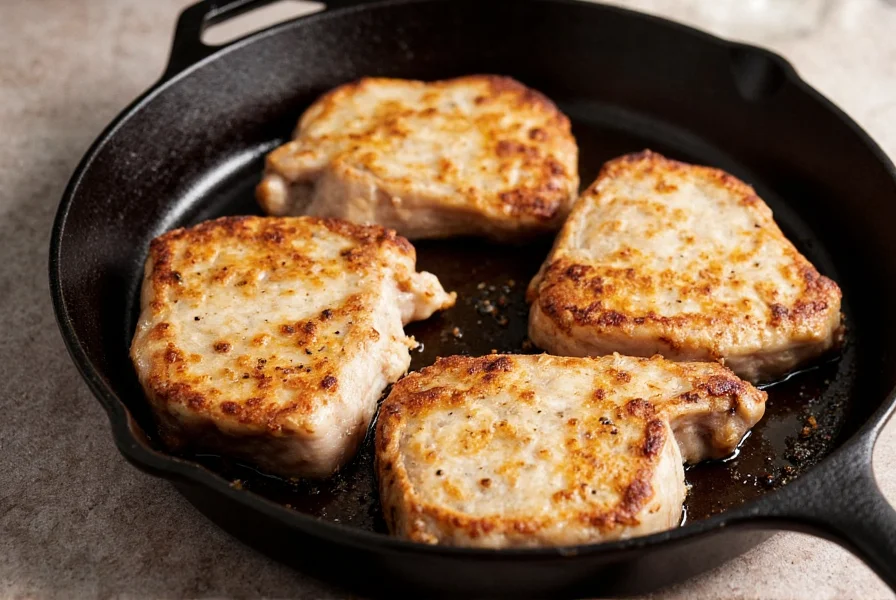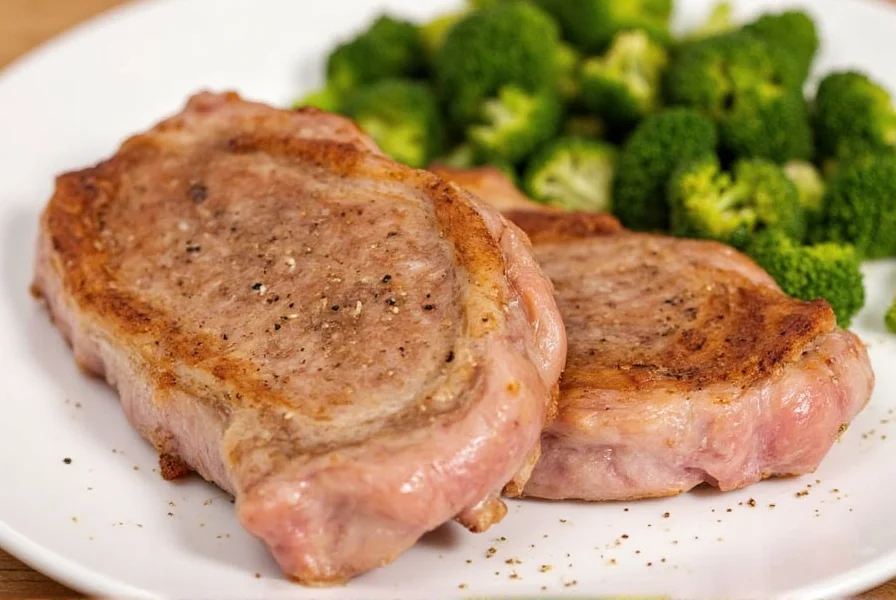When executed properly, salt and pepper pork chops showcase how minimal seasoning can maximize flavor. This classic preparation highlights the natural richness of quality pork while creating a beautifully caramelized crust through proper searing technique. Unlike complex marinades that mask the meat's inherent taste, this method respects the ingredient while transforming it through precise cooking.
Selecting the Right Pork Chops
For optimal salt and pepper pork chops, choose bone-in rib or loin chops cut at least 1½ inches thick. The bone adds flavor during cooking and helps prevent overcooking by conducting heat more slowly than the meat. Look for chops with marbling throughout the meat and a pinkish-red color rather than grayish tones. Avoid "enhanced" or "self-basting" pork chops that contain added sodium solutions, as these interfere with proper seasoning control.
| Pork Chop Type | Best For Salt & Pepper Preparation | Notes |
|---|---|---|
| Bone-in Rib Chop | Excellent | Rich marbling, tender texture, best flavor development |
| Bone-in Loin Chop | Very Good | Leaner but still flavorful, watch cooking time carefully |
| Boneless Chop | Adequate | Cooks faster, more prone to drying out |
| "Enhanced" Pork | Poor | Contains added sodium solutions that disrupt seasoning |
Essential Seasoning Technique
The magic of salt and pepper pork chops lies in proper seasoning technique. Use coarse kosher salt (like Diamond Crystal) rather than table salt, as its larger crystals adhere better and provide more even coverage. Freshly cracked black pepper from a quality peppermill delivers significantly better flavor than pre-ground pepper. Season at least 45 minutes before cooking—ideally up to 24 hours in advance—to allow the salt to penetrate the meat and enhance both flavor and moisture retention.
For a standard 1½-inch thick chop, use approximately 1 teaspoon of kosher salt and ½ teaspoon of freshly cracked black pepper per side. Don't be afraid of generous seasoning; much of it will fall off during cooking, and properly seasoned meat should taste seasoned throughout, not just on the surface.
Step-by-Step Cooking Method
Follow these precise steps for restaurant-quality salt and pepper pork chops at home:
- Remove chops from refrigerator 30-45 minutes before cooking to bring to room temperature
- Pat thoroughly dry with paper towels (critical for proper searing)
- Season generously with salt and pepper on all sides
- Heat 1-2 tablespoons of high-smoke point oil (avocado or canola) in oven-safe skillet over medium-high heat
- Sear chops for 4-5 minutes until deep golden brown crust forms
- Flip and sear opposite side for 3-4 minutes
- Transfer skillet to 400°F preheated oven
- Cook for 6-10 minutes until internal temperature reaches 140-145°F
- Rest for 5-7 minutes before serving (temperature will rise to 145°F)

Professional Tips for Perfect Results
Mastering salt and pepper pork chops requires attention to detail. Here are key techniques professional chefs use:
- Temperature control: Use an instant-read thermometer—don't guess on doneness. Remove chops at 140°F as they'll continue cooking while resting.
- Sear quality: Listen for the proper sizzle when the chop hits the pan—too quiet means the pan isn't hot enough; violent splattering means it's too hot.
- Resting time: Never skip the resting period. This allows juices to redistribute throughout the meat rather than spilling out when cut.
- Salt timing: For best results, salt chops at least 45 minutes before cooking to allow penetration without drawing out excessive moisture.
Avoiding Common Mistakes
Many home cooks make these critical errors when preparing simple salt and pepper pork chops:
- Using thin chops: Anything less than 1½ inches thick will overcook before developing a proper crust
- Overcrowding the pan: Causes steaming rather than searing—cook no more than 2 chops at a time in standard skillet
- Moving chops too soon: Wait until they release naturally from the pan to avoid tearing the developing crust
- Skipping the oven finish: Thick chops need the gentle, even heat of the oven to cook through without burning the exterior
- Cutting immediately: Slicing too soon releases precious juices—always rest for at least 5 minutes
Serving Suggestions
The simplicity of salt and pepper pork chops makes them incredibly versatile. Pair with:
- Garlic mashed potatoes and roasted asparagus for a classic combination
- Apple sauce or cranberry relish for a sweet contrast to the savory meat
- Simple green salad with vinaigrette to cut through the richness
- Crusty bread to soak up the flavorful pan drippings
For an extra flavor dimension, deglaze the pan with a splash of apple cider vinegar or chicken stock after removing the chops, scraping up the browned bits to create a quick pan sauce.

Simple Variations to Explore
Once you've mastered the basic salt and pepper pork chops recipe, try these subtle enhancements:
- Herb-infused: Add a few sprigs of fresh thyme or rosemary to the skillet during the oven phase
- Garlic finish: Add 2-3 smashed garlic cloves to the pan during the last 2 minutes of searing
- Lemon zest: Grate fresh lemon zest over the finished chops for bright acidity
- Pepper variations: Experiment with different pepper blends (white, pink, or mixed peppercorns)
Remember that the beauty of this preparation lies in its simplicity—any additions should complement rather than overwhelm the natural pork flavor.
Frequently Asked Questions
How long should I cook salt and pepper pork chops?
For 1½-inch thick bone-in pork chops, sear for 4-5 minutes per side in a hot skillet, then finish in a 400°F oven for 6-10 minutes until reaching 140-145°F internal temperature. Total cooking time is typically 15-20 minutes depending on thickness. Always use a meat thermometer for accuracy.
Should I salt pork chops before cooking?
Yes, salting pork chops at least 45 minutes before cooking (up to 24 hours) significantly improves results. The salt penetrates the meat, enhancing flavor throughout and improving moisture retention during cooking. Pat dry before searing to ensure proper crust formation.
Why are my salt and pepper pork chops tough?
Tough pork chops usually result from overcooking or using too thin cuts. Pork chops should be cooked to 145°F maximum internal temperature (measured after resting). Chops less than 1½ inches thick often overcook before developing a proper crust. Always let chops rest for 5-7 minutes after cooking to allow juices to redistribute.
What's the best pan for cooking salt and pepper pork chops?
An oven-safe cast iron skillet is ideal for salt and pepper pork chops as it retains heat exceptionally well for proper searing and can transition directly to the oven for finishing. Heavy-bottomed stainless steel skillets also work well. Avoid non-stick pans as they don't develop the same quality crust.
Can I make salt and pepper pork chops without using the oven?
Yes, but only with thinner chops (under 1 inch). For thicker chops, the oven finish is essential to cook through without burning the exterior. If avoiding the oven, reduce chop thickness to 3/4 inch and cook entirely on stovetop over medium heat for 3-4 minutes per side, checking temperature frequently to prevent overcooking.











 浙公网安备
33010002000092号
浙公网安备
33010002000092号 浙B2-20120091-4
浙B2-20120091-4